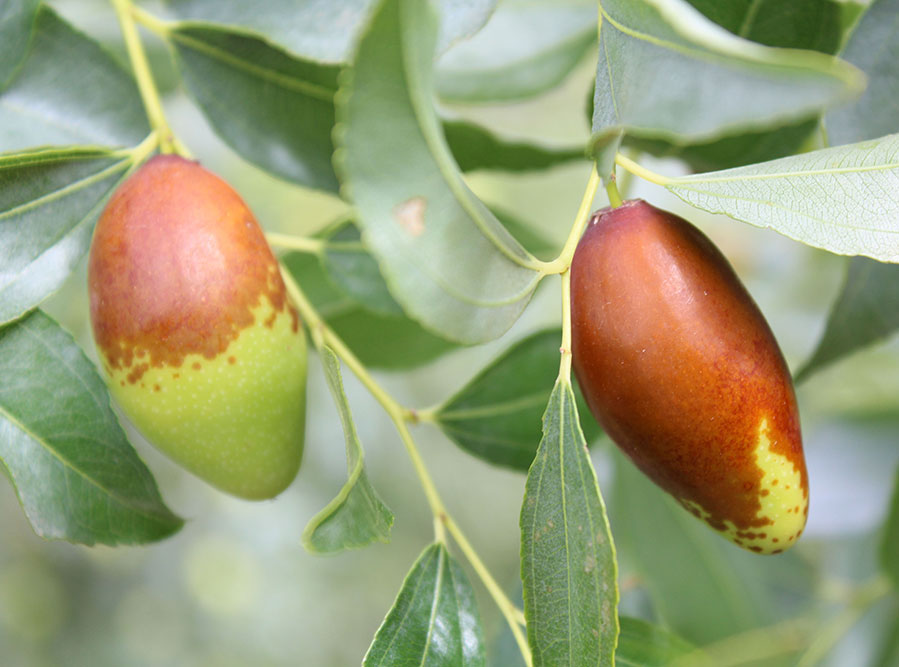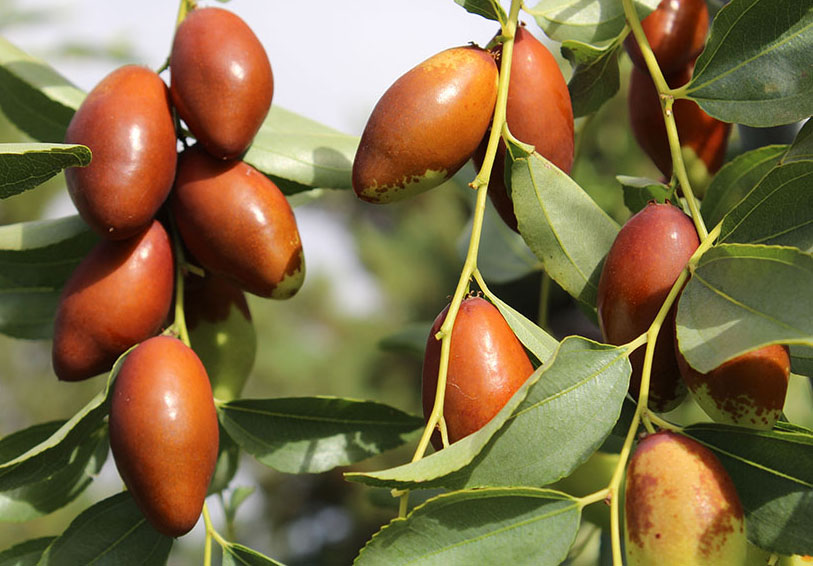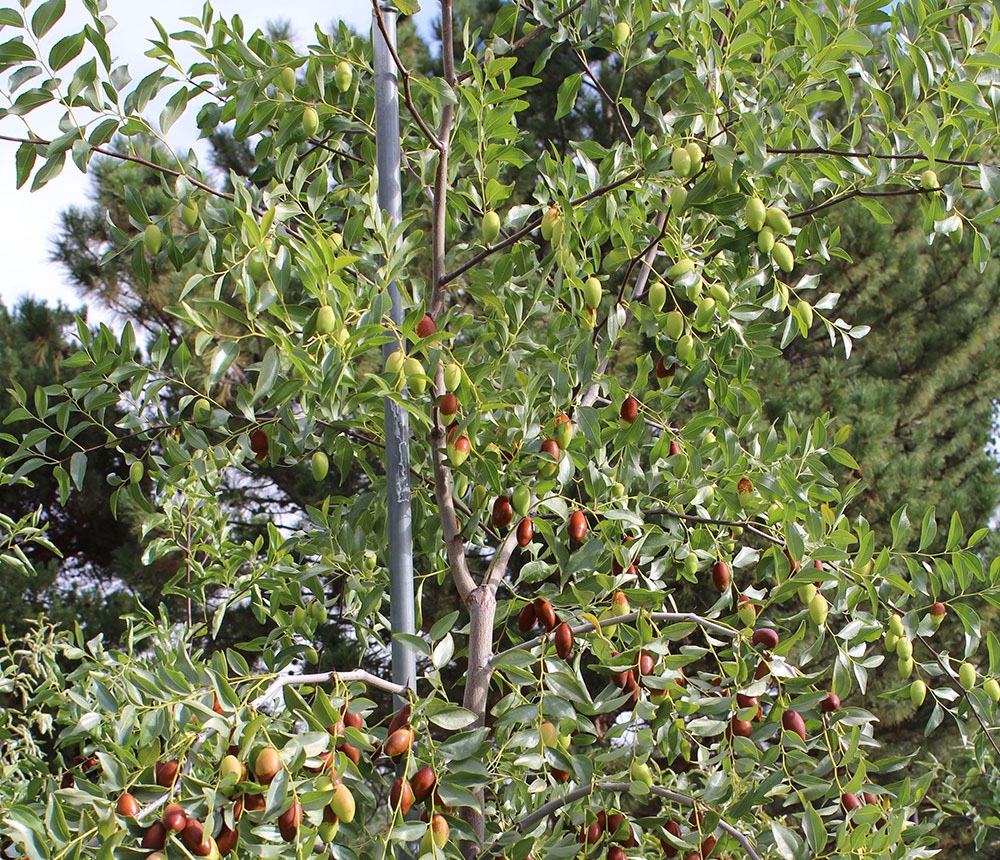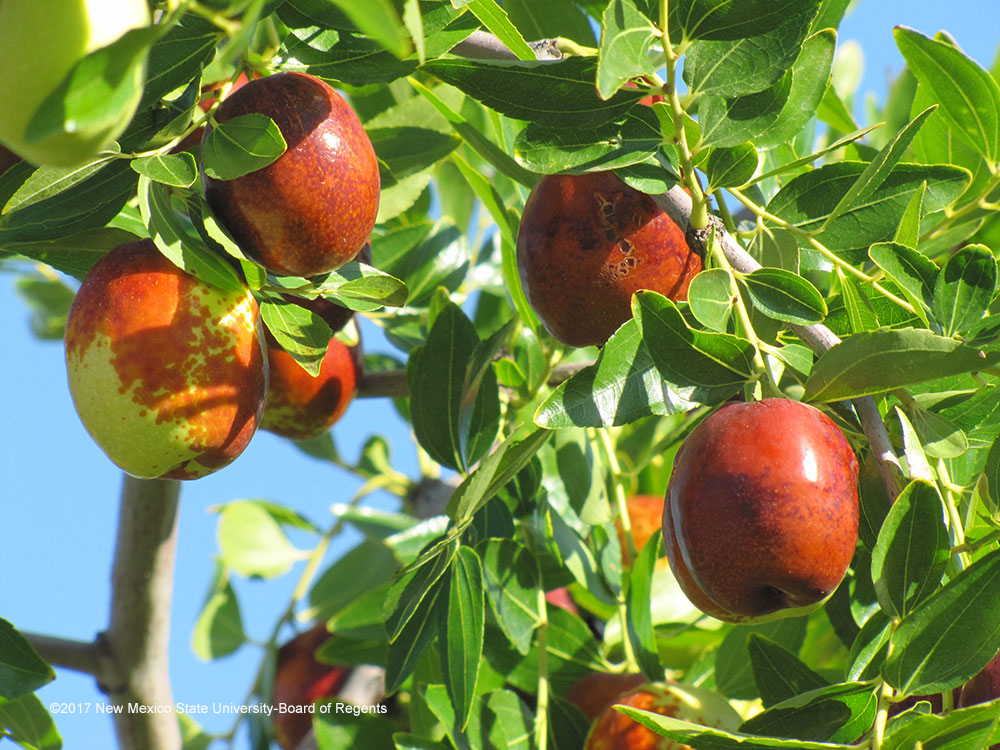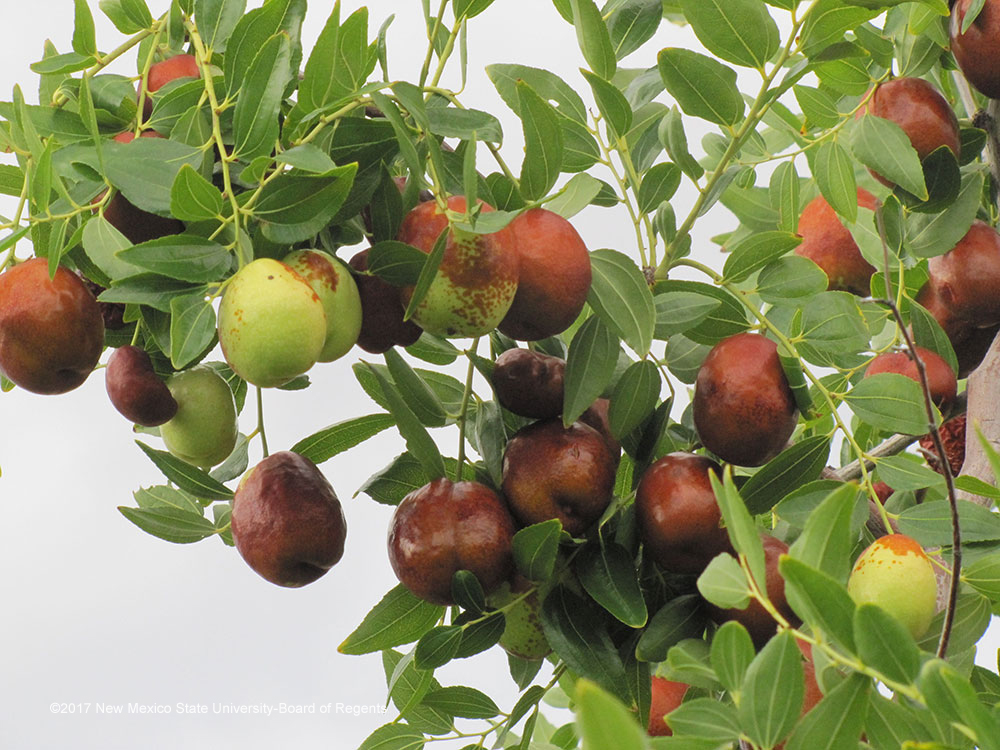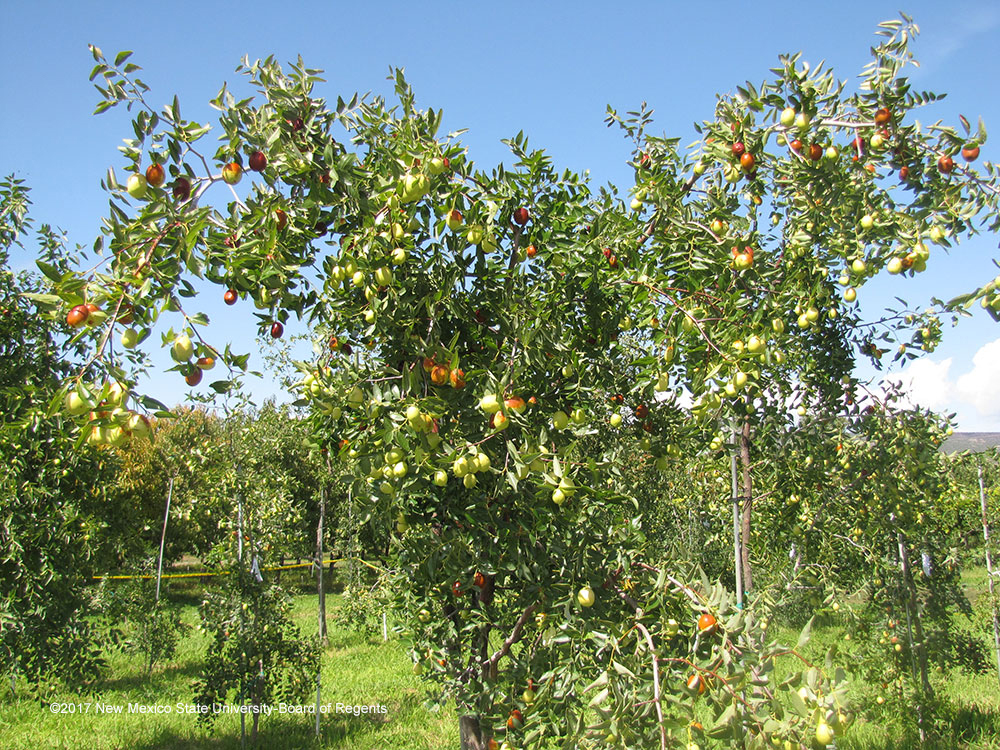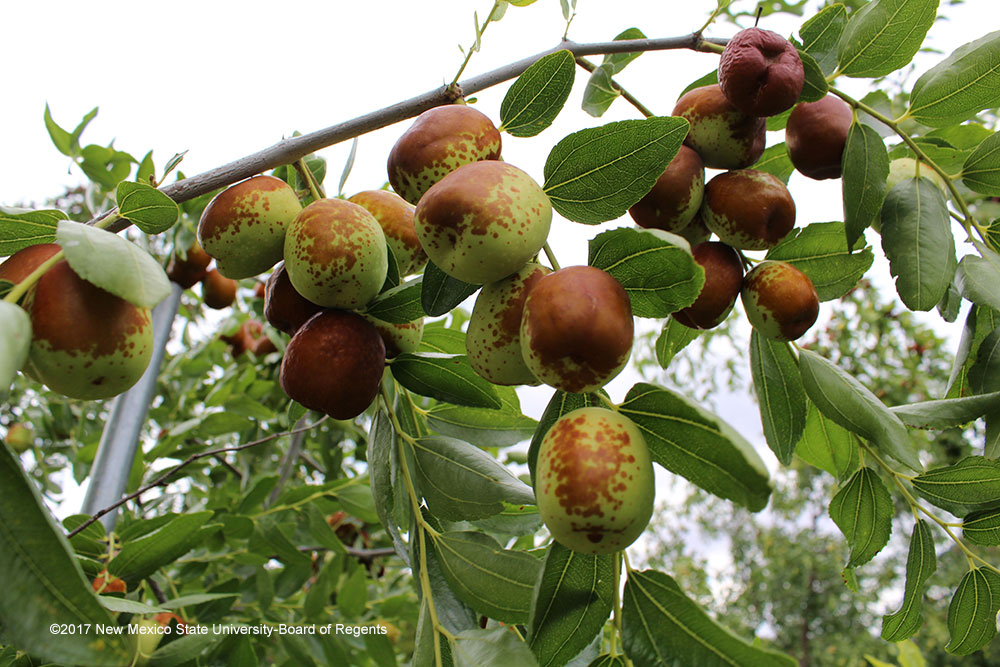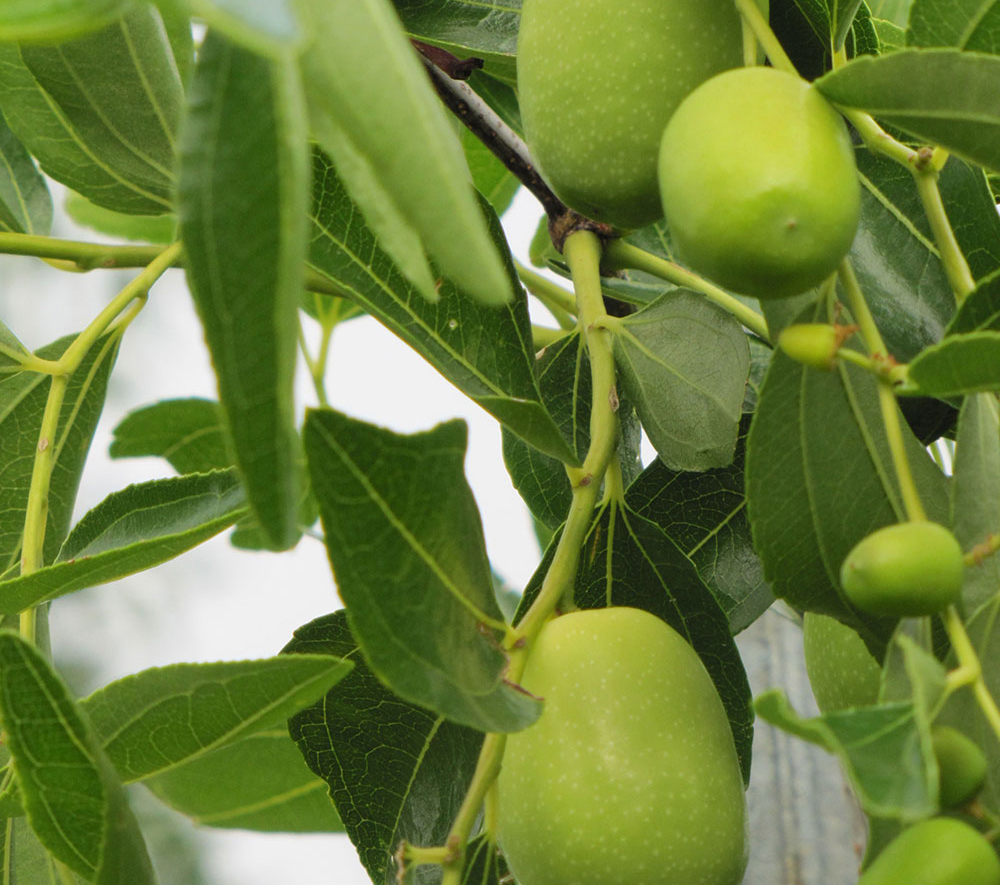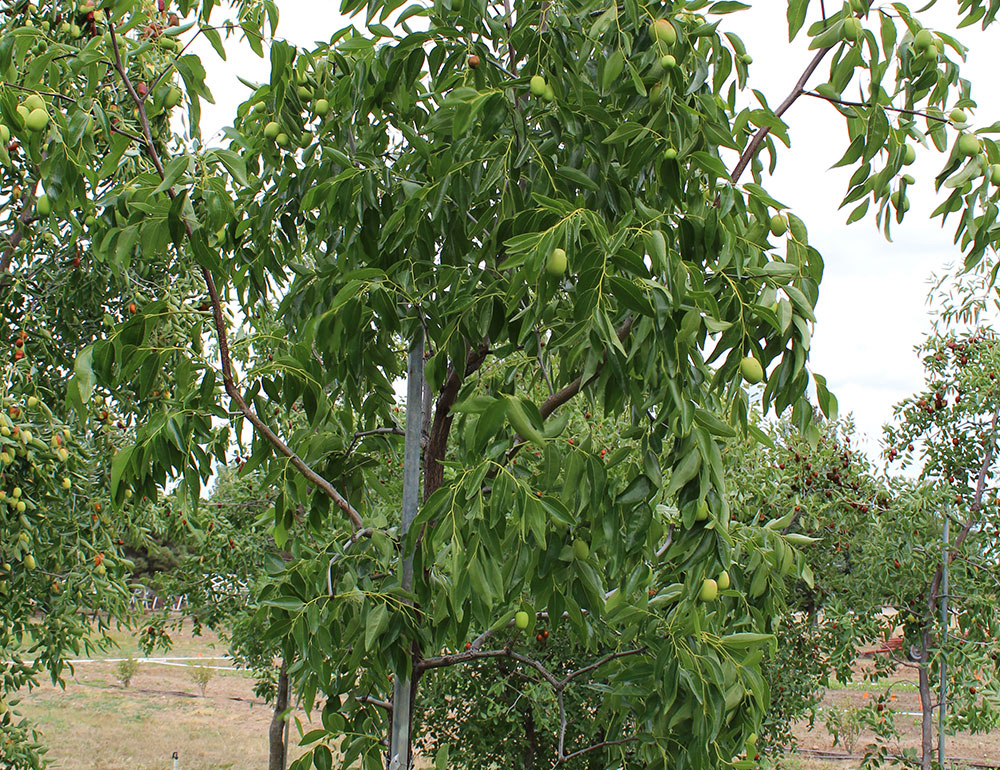For Fresh Eating
Click thumbnail images below to see full sized-image.
AmeriZao™ Alcalde #1
©2024 New Mexico State University- Board of Regents
AmeriZao™ Alcalde #1 (‘七月鲜’, ‘Qiyuexian’, AMERIZAO™ Alcalde #1, AUTUMN BEAUTY™): Large-fruited, early-ripening. Origin: Northwest A&F University, Shaanxi, China, released 2003. Imported separately by J. Gilbert (year not known) and New Mexico State University Alcalde Center in 2011. Fruit: large, 25-30 g; ovoid; skin dark red, shiny; 28.9-32.3_ Brix for full-red fruit in central and northern New Mexico; flavor good; ripens early, half red/half creamy in early September at Los Lunas, NM, and mid-September at Alcalde, NM. Tree: compact, vigor moderate to weak; blooms June-July at Alcalde; yield medium; good for fresh use, also for drying in semiarid areas; suitable for marginal regions with short growing seasons.
Chico
©2024 New Mexico State University- Board of Regents
Chico: (‘GI 7-62’): Midseason jujube for fresh use. Origin: Chico Plant Introduction Station, Chico, CA, by W. Ackerman. ‘So’ open pollination seedling. Fruit: medium to large, 15-17 g; oblate; texture fine; flavor tartsweet, 26.2-32.5_ Brix for full red fruit in New Mexico; ripens midseason, harvest period long; productive; for fresh use. Tree: spreading, bushy with plenty of branches; spiny; popular in Australia, cultivation limited in U.S.
AmeriZao™ Dabailing
©2024 New Mexico State University- Board of Regents
Dabailing: (‘大白铃’; AMERIZAO™ Dabailing): Origin: Shandong Institute of Pomology, Taian, Shandong Province, China; released 1999. Imported into the US in 2011 by New Mexico State University. Fresh eating cultivar with large fruit. 25-30g, 25-30_ Brix. ‘Li’ and ‘Dabailing’ had identical DNA sequences in genotyping with SNP markers. See ‘Li’.
AmeriZao™ Daguazao
©2024 New Mexico State University- Board of Regents
Daguazao: (大瓜枣,AMERIZAO™ Daguazao): Origin: a selection from Donge county, Shandong Institute of Pomology, released in 1998. imported into the US in 2011 by New Mexico State University. Large fruit, 25-30g in central and southern NM. 18-20g in northern NM. 25-30_Brix. Mid-season cultivar. Productive trees, medium-sized canopy.
AmeriZao™ Dongzao
©2024 New Mexico State University- Board of Regents
Dongzao: (‘冬枣’ , ‘Winter Jujube’; AMERIZAO™ Dongzao). Top-quality Chinese cultivar for fresh eating; crisp, juicy, with melting texture. Origin: Traditionally grown in northern Shandong Province and eastern Hebei Province, China, near Bohai Bay; imported to U.S. by New Mexico State University. There have been other selections from ‘Dongzao’, such as strains of ‘Zhanhua Dongzao’ (‘沾化冬枣’). See also ‘Sandia’. Fruit: midsize, 12-13 g in northern New Mexico; 14-17 g in central and southern New Mexico, maximum weight 24 g; globose; can be eaten starting from creamy stage; fresh eating quality best, sweet, crisp, juicy, with melting texture; 30-36_Brix in New Mexico; ripens late. Tree: midsize; bushy, plenty of branches; not precocious; yield medium without cultural intervention (girdling or gibberellin spray); suitable for commercial growers and home gardeners; suitable for USDA Zone 7 and higher.
GA866
©2024 New Mexico State University- Board of Regents
GA866: Very sweet, late ripening, mainly for fresh use. Origin: Chico Plant Introduction Station, Chico, CA, by W. Ackerman. Parentage unknown. Fruit: midsize, 15-18 g; elongated, can be slightly curved, stigma end tapered; flavor very sweet, 36-39.5_ Brix in central and southern New Mexico; ripens late; mainly for fresh use, also good for drying. Tree: growth habit very upright, with few branches on trunk; not precocious, nor productive for young trees; yield medium.
AmeriZao™ Gaga
©2024 New Mexico State University- Board of Regents
Gaga: (尜尜, AMERIZAO™ Gaga)Origin: China. Imported into the US by New Mexico State University in 2011. Small fruit, pointed at both ends, US football shaped. The Chinese character 尜means small-large-small indicating its shape. Excellent fresh eating quality. Good looking fruit, also nice back yard trees. Early- to mid-season. Genotyping with SNP markers showed that Gaga and Maya had identical sequences. Tree growing habits were also similar. Gaga might be slightly different shape than Maya, and Maya is also called Gaga in China. See Maya.
HoneyJar
©2024 New Mexico State University- Board of Regents
Honeyjar: (‘蜂蜜罐’, ‘Fengmiguan’, ‘Honey Jar’):Small fruit of excellent quality, for home gardens. Origin: China; imported by R. Meyer; released 1995. Fruit: small, 6.5-7.8 g, but if cropped less, can be larger; short obovate; skin very thin; flesh texture fine, very juicy; fresh eating quality excellent; 27.5-30_ Brix in northern to central New Mexico; ripens early; full red fruit shrank sooner than other cultivars. Tree: midsize; leaves half-folded; productive; suitable for home gardeners, especially in marginal regions with short growing seasons; small fruit size and higher picking cost may limit commercial use.
AmeriZao™ Jing-39
©2024 New Mexico State University- Board of Regents
Jing39: (京枣39, AMERIZAO™ Jing39):Origin: a selection from Haidian District by Beijing Institute of Forestry and Pomology in 2002. Fruit: large and uniform, early-mid season cultivar, 22-25g at Las Cruces, NM. 25.5-26.0_Brix. Heavy producer. Tree: Very productive, limited branches. Produced 90-100lb fruit for 5-6 year-old tree at Las Cruces, NM.
Li
©2024 New Mexico State University- Board of Regents
Li: (‘梨枣’; ‘临漪梨枣’ , ‘Linyi Li’; ‘山西梨枣’ , ‘Shanxi Li’). Large, highly productive cultivar, formerly dominant for fresh use in U.S. Origin: Anyi County, Shanxi Province, China; imported to U.S. 1914 by F.N. Meyer, USDA, PI 38249; introduced 1924. See also ‘Dabailing’. Fruit: large, 25-30 g; globose to ovoid; skin brown; 25.7-32.8 _Brix for full red fruit in New Mexico; ripens midseason; flavor good at half red/half creamy stage to full-red stage; primarily for fresh use; flavorless and retaining scratches when harvested at creamy or earlier stage. Tree: large; growth habit spreading, branches bent down due to heavy crop on current-year shoots; yield heavy fruit; maturity non-uniform, multiple harvests recommended; formerly dominant fresh-use cultivar in U.S., used for drying in Lucerne Valley, CA.
Li-2
©2024 New Mexico State University- Board of Regents
Li-2:From late Roger Meyer in California. Origin not sure. Fresh eating cultivar. Some people say it matures later and is more productive than Li. DNA genotyping revealed Li-2 with identical sequences with Li.
AmeriZao™ Liuyuexian
©2024 New Mexico State University- Board of Regents
Liuyuexian: (AMERIZAO™ Liuyuexian):Origin: Shandong Province, China. Imported into the US in 2011 by New Mexico State University. Medium sized fruit 10g in northern and 13g in southern NM with 29-32_Brix. KFC was more productive with smaller fruit than Liuyuexian while Liuyuexian had relatively larger fruit, while crop load also played a factor here. Genotyping with SNP markers indicated that Liuyuexian and KFC had identical sequences. See KFC.
AmeriZao™ Maya
©2024 New Mexico State University- Board of Regents
Maya: (‘马牙枣’ translation “horse tooth”; AMERIZAO™ Maya): Small, attractive fruit with excellent fresh eating quality, for home use. Origin: Beijing, China; imported to U.S. 2011 by New Mexico State University. Fruit: small, 6-7 g; tapered on both ends with largest diameter in the middle (American football shaped); fresh eating quality excellent, 28-33.5 _Brix in central and southern New Mexico; harvest season long. Tree: upright, few large branches, with long side branches; early and productive; suitable for fresh use in home gardeners and marginal regions with short growing seasons; small fruit and higher picking costs may limit commercial use.
Redland
©2024 New Mexico State University- Board of Regents
Redlands #4: (‘Redlands’):Large, round fruit similar to ‘Li’. Origin: Dr. Berry, Redlands, CA. Identical DNA sequences with ‘Li’ in genotyping with SNP markers; synonym or mutation of ‘Li’. Fruit: large, 27-28.5g; 25.0-31.0 _Brix. Tree: similar to ‘Li’. See ‘Li’.
Russian 2
©2024 New Mexico State University- Board of Regents
Russian 2: (BLACK SEA™):Small fruit, suited to home gardens, especially in areas with short growing seasons. Origin: Nikita Botanical Garden, Ukraine; imported by J. Gilbert, named BLACK SEA™; renamed ‘Russian 2’ or ‘Kitaiski 2’ by R. Meyer. Fruit: small, 6-7g; ovoid; skin dark brown/red; flesh very crisp and juicy; 30-33 _Brix in central and northern New Mexico; fresh eating quality excellent; ripens early. Tree: compact tree; productive; suitable for home gardens, especially in marginal regions with short growing seasons; small fruit size and higher picking cost may limit commercial use.
AmeriZao™ Sandia
©2024 New Mexico State University- Board of Regents
AmeriZao™ Sandia: Origin: Imported from China to U.S. 2011 by New Mexico State University. Identical DNA sequence with ‘Dongzao’ in genotyping with SNP markers; synonym or mutation of ‘Dongzao’. See ‘Dongzao’.
Shanxi Li
©2024 New Mexico State University- Board of Regents
Shanxi Li: Shanxi has become popular in the last 30 years in China. Big fruit, very good fresh eating cultivar. Similar to Li, early fruiting and productive. It can be pruned heavily and produce well on the current year's shoots.
Topeka
©2024 New Mexico State University- Board of Regents
Topeka: A cultivar originated in Kansas State. Very late fresh eating cultivar. Too late for northern New Mexico. Limited information.
AmeriZao™ Zaocuiwang
©2024 New Mexico State University- Board of Regents
Zaocuiwang: (‘早脆王’ translation “early crisp king”; AMERIZAO™ Zaocuiwang, AMERIZAO™ ZCW)Early to midseason with large fruit, for fresh use. Origin: Cangzhou Jinsixiaozao Nursery, Cangzhou, Hebei Province, China. ‘Shandong Lizao’ (‘山东梨枣’, ‘Shandong Pear’) selection, with DNA sequences identical to parent in genotyping with SNP markers; released 2001; imported to U.S. 2011 by New Mexico State University. Fruit: large, 22-26 g; ovoid, slightly tapered at stem end; skin bright brown/red; texture fine; flavor excellent; 28-33.6 _Brix for full-red fruit in New Mexico; ripens early. Tree: midsize; growth habit spreading; precocious, yield medium to high; fruits hang ornamentally on tree; only jujube cultivar in the U.S. without pollen; suitable for home gardeners and commercial production, including marginal regions with short growing seasons.
